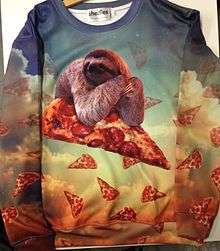All over print
In streetwear fashion, an all over print (also known as all-over-print) is a print composed of a design that is repeated across the entire surface of a garment. The image is on both the front and back. Often, such prints are screen-printed. Other processes include dye-diffusion of the fabric itself.
History
All-Over Printing is a function of broader printing contextual development, in particular, the advent of sublimation printing 1957. This is not to be confused with commercial sublimation on cellulose in 1929, as the substrate is polyethylene terephthalate (PET). Rather, the commercial process as developed by Noel de Plasse in Lainere de Roubaix, France.[1]
Utility
Since it's commodification, all-over printing strategies are being widely applied to fashion. Due to the variability of graphics, the high-quality of the layering, the lack of print-texture, and the flexibility in design, many outlets are resorting to this method such as Blue Notes.

Technique
The process is similar to the dye-diffusion approach: a graphic is printed onto a sheet of high-release paper and then transferred onto the chosen apparel using high heat and pressure. Heat converts the solid dye particles into a gas through sublimation. The liquid phase is skipped due to the instantaneous of the physical change. This immediacy bonds the released chemicals to the polyester fibres. Unlike screen printing and direct-to-garment digital printing, this is not digital. Instead, the dye is absorbed by the fabric for a fantastic soft-to-the-touch feel and breathability. The design is printed on 100% polyester material.
Often, this is done on white garment only as this base colour allows for the best applicability. The types of garments available are T-shirts, hoodies, sweaters, socks, bags, and much more.
Advantages and Disadvantages
Advantages of dye-sublimation over other methods of textile printing:[2]
- Pictures do not peel off fabric, unlike typical screen printing.
- Dye does not mount on fabric.
- The intensity of colour is often unmatched due to the direct permeation of dye.
- No need to half-print screens or cut fabric.
- The continuous nature of the print allows all of the medium to be a canvas.
Disadvantages:
- Speed is reduced due to continuos nature of printing.[3]
- Possibility of white creases and irregular printing per-batch.
- Some dyes work better than others.
References
- ↑ Gibson, Joseph W (1996). "History and Development of the Thermosol Process". Textile Chemist & Colorist. pp. 27–22. Retrieved 2017-11-15. Check date values in:
|access-date=(help) - ↑ Sidles, Constance J. (2001). Graphic Designer's Digital Printing and Prepress Handbook. Rockport Publishers. pp. 26–27. Retrieved 2011-10-05.
- ↑ Chemical technology in Printing and Imaging Systems, ed. J A G Drake, 1993, pp 73-85